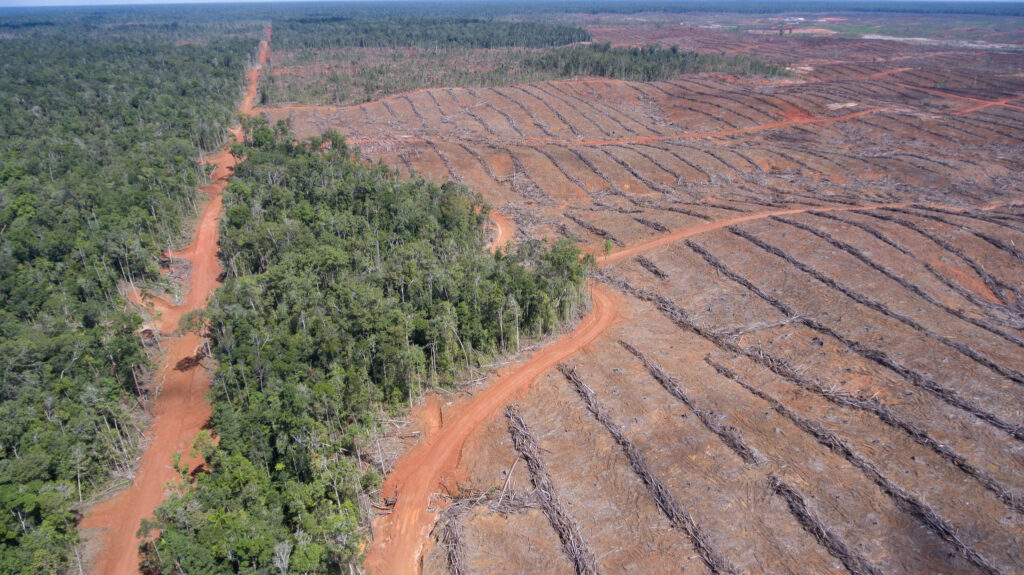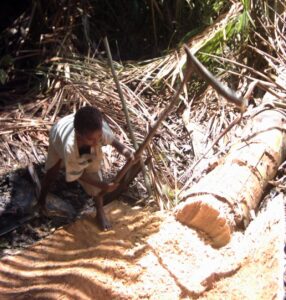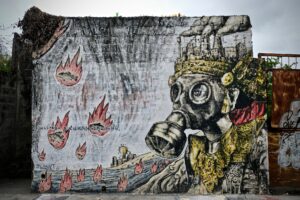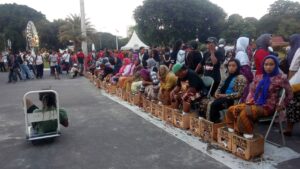
Thinking Infrastructures in Jokowi Regimes: Private Investment for Infrastructures
Article by Jonathan S. Parhusip
In thinking infrastructures, the paper examines infrastructural development policies as a set of infrastructures that “binds” us and rethinks a broad range of phenomena that infrastructures bring to us. The article offers a critical analysis and reassessment of modern logistics and infrastructure projects in Jokowi’s regimes. Throughout the article, I highlighted the gaps between policy and its effects on local people and local ecology. Instead of celebrating infrastructural development projects as policies that favour the people, the essay revisits the ideology of modern logistics and reexamines the purpose of the recent development of food estates, cement factories, and electric steam power plants in Indonesia. These examples show that infrastructural projects are misleading, causing suffering to the indigenous communities and damaging local ecologies. Therefore, it is crucial to challenge the narrative that establishing new factories will create jobs for local communities and reduce poverty.
Keywords: infrastructure, private investment, food estate, cement, power plant
Header image “Perilous: Korindo, Land Grabbing and Banks” by Rainforest Action Network is licensed under CC BY-NC 2.0.
Policy as Infrastructure
The policy is generally associated with a program, an action taken to solve an issue or make changes. There is an underlying assumption that the policy is a good thing. It fixes things up (Bacchi, 2009). Public policy is understood as government programs, and by their nature, policies make changes for a better future. The study of policy as infrastructure is “to make visible the invisible and raise awareness of imperceptible systems” that make our worlds (Mattern, July 2013; p. 6), and to look into how individuals, communities, organizations, and entire markets governed and reexamined the assembling of a wide variety of actors and entities bind together (Bowker, 2019).
Policy as infrastructure is a manifestation of “modern logistics,” as suggested by Stefano Harvey and Freed Moten (Stefano Harvey in Cuppini & Mattia, 2018; Harney & Moten, 2013). Harney remarked that logistics evolved, “it is not just about how to transport large amounts of commodities or information or energy, but also about the sociopathic demand for access: topographical and jurisdictional” (Cuppini & Mattia, 2018; p.96), that is the ambition to occupy territory and resources. Oligarchs invested their wealth during the election campaign, hoping to get a position in the government agencies or carry out government development projects. In regards, the government issued bills that juridically give access to the oligarchs. At this stage, the oligarchs extract the value from human activities or the raw material from nature (Mezzadra and Brett, 2013). Thus, the notion of “policy as infrastructure” is the materialization of policy as networks that facilitate the transfer of power (over territory) from the state to national or transnational companies (oligarchs).
Jokowi’s infrastructural projects and Private Enterprises investment
Since his candidacy for the 2014 presidential election, Joko Widodo’s (or Jokowi for short) is known as a ‘man of the people’ and is an outsider Indonesian political elites. He is the politician that grew up after the fall of Soeharto’s New Order Regimes. He has no relatives or relations to the people in power during the New Order. Jokowi’s campaign on infrastructure development has generated millions of passionate followers across the country. However, as many observers (Hadiz & Richard, 2014; Gokkon, 2019) argued, Jokowi turned and became embedded in the oligarchy system. He mobilized oligarchs to run the state economy hand in hand with the governments. The oligarchs are empowered because of their wealth-power to fund the infrastructural projects in the country (Winters, 2013).
Following his initial campaign, Jokowi issued laws that accommodate investors to invest in the country. In 2016, Jokowi issued Presidential regulations No. 3 the Year 2016 (Amended as No. 58 the Year 2017), a list of 245 National Strategic Projects across Indonesia. Infrastructural development under Jokowi is regimes categorized and pursued according to its urgency in public services. The list of priority projects includes the construction of 2650 km of roads, 1000 km of highways, 15 units of international standard airports, 24 large-scale new ports, 49 new reservoir units, 1 million hectares of new rice fields, 5,257 units of cheap flats, 515,711 housing units, nine special economic zones, 14 new industrial estates, and many more (KPPIP, n.d.). For the entire project, an estimated total of IDR 4,197 trillion (about USD 299 billion) is required; IDR 525 trillion from the State Budget, IDR 1,258 trillion from State-owned enterprises, and IDR 2,414 trillion private enterprises (KPPIP, n.d.). As we can see, more than 50% of the financialization of the projects comes from privately owned enterprises. On October 5, 2020, Joko Widodo signed and passed the Omnibus Law on Job Creation, following up his promises.
On many occasions, Jokowi emphasized the importance of investment for sustainable infrastructure projects in Indonesia. He assured investors that doing business in Indonesia was a profitable opportunity. The state would facilitate the business licensing process and carry out reforms to meet investors’ needs (Negara, 2016). Some of the policies that Jokowi has carried out during his two years in office are the infrastructure development program, deregulation, and the tax amnesty program. Jokowi introduced Public Private Partnership (Kerjasama Pemerintah dan Badan Usaha, KPBU), non-state budget infrastructure funding, and asset securitization (KPPIP, n.d.) as a solution to finance his plan. In practice, these financing schemes give the private enterprises a significant role to build and manage the infrastructure projects, while the government’s role is more as a guarantor to bind us together. Many studies have discussed this shift in the role of the state by looking at how the infrastructure sector experiences privatization and financialization and operates using business logic (Davidson, 2021; Wilson et. al., 2019; Braadbaart, 2007). The trend of privatization and financialization in the infrastructure sector means that infrastructure projects, which are actually public services and must operate non-commercially, will be fully controlled by the private enterprises, and their use will then be commercial. As a result, gradually and in the long term, the price of accessing public services will become increasingly expensive. It is because the objective of private business operations is to make profits. In what follows, I reexamine the purpose of the recent development of food estates, cement factories, and electric steam power plants in Indonesia and shows the misleading trajectories of the projects.
-
Food estate: creating dependency on the capitalist system
The food estate project was part of the Food Security and Nutrition agendas and intended to reduce dependence on food imports. The first food estate project called Merauke Integrated Food Energy Estate (MIFEE) in Papua was started in 2010 by President Susilo Bambang Yudhoyono (SBY). On an area of 1.3 acres, the government granted licenses to cultivate food crops, sugarcane, palm oil, and industrial plants to 45 private companies (Arumingtyas & Elisabeth, 2020). In 2015, Jokowi continued and expanded the projects to the islands of Kalimantan and Sumatra. However, food estates do not cultivate plants that are the most imported commodities, namely wheat, salt, and soybean. As Central Statistics Agency noted that one of the largest food commodities imports for the January-November 2018 period are wheat and meslin, which reached 9.2 million tons, followed by sugar weighing 4.6 million tons, salt 2.5 million tons, soybean 2.4 million tons, and rice 2.2 million tons (Katadata, 2019). The value of these imports is about USD 2,330 million (Kemendag, 2020).
Another facet of the food estate is that many conflicts arise between indigenous people and private companies. In The Mahuzes, a documentary film by Watchdoc (Watchdoc Image, 2015), we can see how indigenous communities are divided and cultures that are thousands of years old disappear in a matter of years. Indigenous people lost their food and economic resources, their knowledge of customs, language, and religion. The indigenous Papuan are food hunters and gatherers, and their staple food is sago from sago trees that grew wild in the forests. However, with the presence of the food estate companies, the forest was converted into rice fields. Indigenous Papuans were marginalized and lost their source of food. They were forced to adapt from food hunter and gatherer lifestyles to farmers. Licenses issued by the government legitimize the confiscation of land belonging to indigenous peoples.

“File:Sago Palm being harvested for Sago production PNG.jpg” by Toksave
is licensed under CC BY-SA 3.0
For indigenous peoples, their lives depend not only on nature but their lives fused with nature. The conversion of nature means threatening the sustainability of indigenous and creating dependence on the capitalist system. For instance, in North Sumatra, incense trees, coffee, and andaliman (Zanthoxylum acanthopodium) are endemic plants in the region and are owned by local farmers (Stefany, 2021). In the presence of the food estate, farmers were forced to destroy the endemic plants and change the endemic plants with the seeds sold by the investor and sell the harvests to the company that invests. Farmers are required to buy not only seeds from private enterprises but also fertilizers and pesticides. For tillage and harvesting, farmers have to rent the machinery from the investing companies.
In such a capitalist system, the farmers are dependent on private enterprises. Their rights as independent farmers are deprived and bound with the interests of the investors. The food estate program is the opposite of traditional farming in North Sumatra or indigenous lifestyles in Papua because when the farmers planted incense trees, coffee, or andaliman on their fields, they didn’t need to buy seeds, pesticides, or fertilizers. They also do not require farming machines for endemic plants because they have to be harvested manually and last for dozens of years. Even more, incense trees lasted for over thirty years and could be inherited over generations.
-
Surplus of electricity from private enterprises
The Jokowi administration granted licenses to construct new power plants amid a surplus electricity supply (Mutia, 2018). For example, in 2016, the surplus of electricity on the Java-Bali route was about 7,153 MW, where the peak usage load was 24,461 MW from the net capable power of 31,614 MW (Antara, 2016). In 2017 the electricity surplus reached 7,000 – 8,000 MW or 31 percent, while until mid-2018, the Java Bali electricity supply recorded a surplus of 7,432 MW (Mediatama, 2017). Most surplus electricity figures are supplied from private power plants or Independent Power Producers (IPP). The State Electricity Company (Perusahaan Listrik Negara, PLN) signed a Power Purchase Agreement (PPA) with the IIP. By signing a PPA contract, PLN is obliged to purchase electricity from IIP’s generators to transmit it to all customers. The PPA bound both parties and lasts up to 30 years on average for all types of power generation. In the contract scheme, there is a so-called take or pay clause (Agustinus, 2017), in which PLN must pay and absorb at least 80 percent of the maximum capacity of the IPP generator. If PLN is unable to absorb 80 percent of the electricity supply from the IPP generator, PLN will be fined. So with the current surplus situation, using or not using the electricity, PLN still has to pay (Al-Ayubby & Gina, 2018).
Seeing the national electricity surplus phenomenon, the government needs to re-evaluate the plan to build new power plants. The investors are giant companies from China, Japan, and Europe, and they choose coal because it cost less. For instance, the Celukan Bawang electric steam power plant located in Celukan Bawang Village, Gerokgak District, Buleleng, Bali, was built by a consortium consisting of China Huadian Engineering, Merryline International PTE, and PT. General Energy Bali. The Celukan Bawang electric steam power plant project’s total investment reached USD 700 million, most of which was obtained from the China Development Bank (Eco-Business, 2020). The Celukan Bawang electric steam power plant has been operating since 2015 with up to 426 MW. It consumes around 5,200 tons of coal every day supplied from coal mines in Kalimantan.

“Silly in Art @slinat ‘Waspada Celukan Bawang'” by labnusantara is licensed under
CC BY-NC-ND 2.0
Several data on the electricity economy and its problems have just been discussed showing the misleading projection in the current infrastructure development program in the electricity sector. However, the existing figures are more than sufficient to conclude that the electricity infrastructure program talks more about investment interests and is entirely far from the needs of the people.
-
Kendeng farmers against cement factories
The case of the construction of cement factories in the North Kendeng Mountains, which later sparked the Kendeng people’s resistance, is a good example to prove that the infrastructural development policies in the cement industry are misleading. In the middle of April 2016, nine women from the Samin community in Rembang, Central Java, set their feet in cement blocks in front of the Presidential Palace and demanded a meeting with President Joko Widodo. The women were protesting against the construction of a Semen Indonesia cement factory near their village, which they argue will disturb the delicate balance of water supply in the Kendeng Mountains (Yulius, 2016). The dramatic protest followed years of demonstrations, which have included sit-ins and establishing a tent city to block the construction of the factory. No doubt, the dramatic images played a part in the success of their protest. The Samin women were demonstrating to protect the local ecosystem, which is crucial for their children and the community’s livelihood. And as mothers, the Samin women were assumed to know what was best for their community. The limestone in the North Kendeng Mountains has been the target of several cement companies in the last decade, such as PT Semen Indonesia, PT Indocement, PT Holcim, and PT Semen Grogoban (Kresna, 2017). Some have operated factories, and some are trying to build factories. These cement companies are competing to control the limestone area of the Kendeng Mountains to cut the cost of transportation and distribution of raw materials, which are commonly imported from outside Java.

Kendeng farmers: using motherhood as a resistance. “File:Aksi Petani Kendeng 1.jpg”
by Yanuar is licensed under CC BY-SA 4.0
The government says that massive infrastructure development requires the use of enormous amounts of cement. Adding to the sentiment of nationalism, the government and its supporters said that infrastructure development requires cement produced by state-owned enterprises and domestic companies in order to be free from dependence on imported cement. Dependence on imported cement is considered to have a negative effect on the national infrastructure development plan if world cement prices increase at any time. However, if we look at them, we find fundamental errors to justify the establishment and operation of new cement factories. In 2016, The Ministry of Industry reported that the national cement production capacity is 92.7 million tons from the demand of only 65 million tons (Kemenperin, 2016) and is estimated to experience an overcapacity of up to 30 million tons in 2017. The operation of several new cement factories which are not matched with market demands has led to industrial overcapacity which is estimated to last until 2025 (Pablo, 2018). In response to this condition, the Indonesian Cement Association (Asosiasi Semen Indonesia, ASI) once raised a proposal to the government to implement a moratorium to establish new cement factories. But the government refused because the moratorium would hinder the entry of investment to the country (Nirmala, 2018). The government’s rejection of the moratorium proposal is understandable when looking at the business logic behind it. The investment disbursed to set up a cement factory costs trillions of rupiah. That much money must come back with a profit. The government considers that the factory’s closure without operating at all conditions where investment has been disbursed can tarnish Indonesia’s face in the eyes of the world’s giant investors and banks involved in the financialization chain.
Friction in the frontiers: misleading trajectories
The calculation of infrastructure development based on economic and business opportunities, as shown, eliminates the participation of people affected. The arena for participation is narrowed through the manipulation of opinions and information and manipulation of the legal process so that it is easy to remove people from their living space. One mainstream narrative used to eliminate people’s participation in infrastructural development projects is that the establishment of new factories will create jobs for local people and reduce poverty. There are indeed opportunities for residents to be employed. However, in reality, only a few are employed.
In conclusion, infrastructural projects carry disruptive impacts on nature and host/indigenous communities. The infrastructure projects carried out by Jokowi’s regimes only satisfy the needs of private enterprises without considering the long-term effects on the community affected. Infrastructure development policies caught in the grip of financialization. Instead, what is measured is the economic and business opportunities for capital accumulation. By looking at how the infrastructure program is running in the food estate, electricity sector, and the cement industry, we have to question for whom the infrastructures are built. Policy, the imaginary infrastructure of the infrastructure, facilitates the transfer of power over the territory to the oligarchs, “binds us to the world in motion and keeps the world practically bound to itself” (Berlant, 2016). The conflicting social interaction of the indigenous communities and infrastructural development projects resulted in “frictions” (Tsing, 2005), a broad range of phenomenon as a prolonged impact of infrastructure development that does not pay attention to the environment.
Bibliography
Agustinus, M. (2017). PLN Bisa Denda Produsen Listrik Swasta, ESDM: Supaya Adil. detikfinance. http://finance.detik.com/energi/d-3412540/pln-bisa-denda-produsen-listrik-swasta-esdm-supaya-adil
Al-Ayubby, Alfian, & Gina Sabrina. (2018, October 16). Membangun Infrastruktur untuk Siapa? IndoPROGRESS. http://indoprogress.com/2018/10/membangun-infrastruktur-untuk-siapa/
Arumingtyas, L., & Elisabeth, A. (2020, October 15). Kala Proyek ‘Food Estate’ Bisa Makin Sulitkan Petani dan Dorong Krisis Pangan. Mongabay Environmental News. http://www.mongabay.co.id/2020/10/15/kala-proyek-food-estate-bisa-makin-sulitkan-petani-dan-dorong-krisis-pangan/
Bacchi, C. (2009). Analysing Policy. Pearson Higher Education AU.
Berlant, L. (2016). The commons: Infrastructures for troubling times*. Environment and Planning D: Society and Space, 34(3), 393–419. http://doi.org/10.1177/0263775816645989
Bowker, G., Miller, P., Kornberger, M., Elyachar, J., Mennicken, A., Nucho, J., & Pollock, N. (2019). Thinking Infrastructures.
Braadbaart, O. (2007). Privatizing water: The Jakarta concession and the limits of contract. In BOOMGAARD P. (Ed.), A World of Water: Rain, Rivers and Seas in Southeast Asian Histories (pp. 297-320). Brill. Retrieved March 5, 2021, from http://www.jstor.org/stable/10.1163/j.ctt1w76vd0.15
Cuppini, N., & Frapporti, M. (2018). Logistics Genealogies. Social Text, 36(3), 95–110. http://doi.org/10.1215/01642472-6917802
Davidson, Jamie S. (2021) Opposition to privatized infrastructure in Indonesia, Review of International Political Economy, 28:1, 128-151, DOI: 10.1080/09692290.2019.1668461
Eco-Business. (2020). Report accuses coal-fired plant in Bali of pollution, loss of livelihoods. Eco-Business. http://www.eco-business.com/news/report-accuses-coal-fired-plant-in-bali-of-pollution-loss-of-livelihoods/
Gokkon, B. (2019, October 23). Indonesia’s new cabinet a ‘marriage of oligarchs,’ environmentalists say. Mongabay Environmental News. http://news.mongabay.com/2019/10/indonesia-cabinet-jokowi-widodo-oligarchs-environment/
Hadiz, V., & Richard Robison. (2014, July 10). President Jokowi vs Oligarchy. New Mandala. http://www.newmandala.org/president-jokowi-vs-oligarchy/
Harney, S., & Moten, F. (2013). The undercommons: Fugitive planning & black study. Minor Compositions.
Jeffrey A. Winters. (2013). Oligarchy and Democracy in Indonesia. Indonesia, 96, 11. http://doi.org/10.5728/indonesia.96.0099
Katadata. (2019). Cek Data: Indonesia Impor Komoditas Pangan? | Databoks. http://databoks.katadata.co.id/datapublish/2019/02/18/cek-data-indonesia-impor-komoditas-pangan
Kemendag. (2020). Perkembangan Impor Menurut Gol. Barang—Portal Statistik Perdagangan. Statistik Kemendag. //statistik.kemendag.go.id/
KPPIP. (n.d.). National Strategic Projects. Komite Percepatan Penyediaan Infrastruktur Prioritas.
Kresna, M. (2017, March 22). Serbuan Pabrik Semen di Pegunungan Kendeng Utara. tirto.id. http://tirto.id/serbuan-pabrik-semen-di-pegunungan-kendeng-utara-clgT
Mattern, Shannon. (July 2013). Infrastructural Tourism. Retrieved January 5, 2021, from http://placesjournal.org/article/infrastructural-tourism/?cn-reloaded=1
Mezzadra, S., & Neilson, B. (2013). Extraction, logistics, finance. 11.
Muhajir, A. (2018, April 26). Greenpeace: PLTU di Celukan Bawang Meracuni Bali. Mongabay Environmental News. http://www.mongabay.co.id/2018/04/26/greenpeace-pltu-di-celukan-bawang-meracuni-bali/
Negara, K. S. (2016). Presiden Jokowi Mengajak Para Investor Berinvestasi di Indonesia | Sekretariat Negara. http://www.setneg.go.id/baca/index/presiden_jokowi_mengajak_para_investor_berinvestasi_di_indonesia
Pablo, S. (2018). Sampai 2025, RI Kelebihan Pasokan Semen 40 Juta Ton/Tahun. News. http://www.cnbcindonesia.com/news/20180928132648-4-35203/sampai-2025-ri-kelebihan-pasokan-semen-40-juta-ton-tahun
Schwab, K. (n.d.). The Global Competitiveness Report. 393.
Sintia, & Kristina. (2021). Petani yang Berdaulat, Adalah Tuan di Tanah Sendiri. http://ksppm.org/id/2021/01/28/petani-yang-berdaulat-adalah-tuan-di-tanah-sendiri/
Stefany, Y. (2021, January 19). Menyoal Food Estate di Sumatera Utara. Mongabay Environmental News. http://www.mongabay.co.id/2021/01/19/menyoal-food-estate-di-sumatera-utara/
Yulius, H. (2016). The Kartinis of Kendeng: Using motherhood as a form of resistance – Indonesia at Melbourne. The Kartinis of Kendeng: Using Motherhood as a Form of Resistance. http://indonesiaatmelbourne.unimelb.edu.au/kartini-of-kendeng-using-motherhood-as-a-form-of-resistance/
Watchdoc Image. (2015, August 29). THE MAHUZEs (full movie). http://www.youtube.com/watch?v=MSVTZSa4oSg&ab_channel=WatchdocImage
Wilson, S., Duffield, C., & Kin Peng Hui, K. (Eds.) 2019. Infrastructure Investment in Indonesia: A Focus on Ports. Open Book Publishers. Retrieved from http://books.openedition.org/obp/11278
